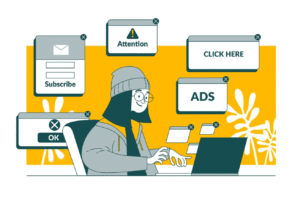How to Sell Programmatic Advertising Like a Pro

Programmatic advertising has transformed how businesses connect with their audiences, combining automation and advanced targeting to deliver highly personalized campaigns. If you’re a business owner, marketer, or advertising sales professional, mastering the art of selling programmatic advertising is essential. Why? It’s expected that programmatic ad spending will hit over $140 billion globally in the upcoming years!
What is Programmatic Advertising?
Programmatic advertising automates the buying and selling of digital ad space using advanced algorithms and real-time bidding (RTB). Instead of manually negotiating ad placements, programmatic platforms allow brands to target the right audience, at the right time, on the right channels, all within milliseconds.
Why Should You Sell Programmatic Advertising?
The value of programmatic advertising lies in its efficiency and precision. Here’s why clients will want this solution and why you should sell it with confidence:
- Highly Targeted Campaigns: Programmatic enables advertisers to reach niche audiences based on data points like demographics, browsing habits, and even behaviors.
- Real-Time Adjustments: Advertisers can tweak campaigns in real time to optimize results.
- Cost Efficiency: With real-time bidding, advertisers only pay for impressions that matter, cutting wasted ad spend.
- Reach Across Channels: Programmatic spans platforms like social media, websites, mobile apps, video, and even connected TV (CTV).
By showcasing these benefits, you’ll position programmatic advertising as a must-have solution for clients aiming to stay competitive.
Step 1: Know Your Product Inside Out
Before you can sell programmatic advertising effectively, you need to fully understand how it works. Clients may have questions about platforms, targeting, or data privacy, and your ability to answer them builds trust and credibility.
Understand the Key Terms
Some buzzwords your clients may mention include:
- DSP (Demand-Side Platform): Software that allows buyers to bid on digital ad space in real-time.
- SSP (Supply-Side Platform): Software used by publishers to make ad inventory available for DSPs to bid on.
- RTB (Real-Time Bidding): The process of buying and selling ads through real-time auctions.
- Third-Party Data vs First-Party Data: Clients must know where the data driving campaigns comes from.
Being able to explain, in simple terms, how these pieces connect will help demystify programmatic advertising for your clients.
Step 2: Identify Your Target Buyer
Not all companies and industries are ready or in need of programmatic advertising. Target businesses that could benefit most from programmatic, such as those with robust online presences or those actively advertising across multiple digital platforms.
Who Should You Target?
- Mid-Sized to Large Brands looking to streamline ad operations.
- E-commerce Companies focused on data-driven advertising.
- Media Agencies that want to offer better solutions to their clients.
- Tech-Savvy MarketersTech-savvy marketers
Make sure to tailor your message to appeal to their pain points, such as wasted budgets or limited reach.
Step 3: Establish the Benefits for Your Client
Your pitch should emphasize how programmatic advertising solves problems or unlocks new opportunities for their business.
Lead With Results
- Highlight ROI Metrics – Explain how programmatic reduces ad spend and increases engagement rates.
- Demonstrate Scalability – Showcase how campaigns can expand across devices and regions quickly.
Case Study Tip
Share case studies or testimonials to prove programmatic’s results. For example, illustrate how Brand A doubled conversions or reduced CPL (cost-per-lead) using programmatic tools. Real-world examples increase your pitch’s credibility and appeal.
Step 4: Focus on Education and Simplification
Programmatic advertising has its complexities. The quicker you simplify it for your clients, the closer you get to a sale.
Break It Down, Step-by-Step
Explain the process clients can expect with your service:
- Audience Research – Show how you tailor campaigns with actionable data.
- Creatives & Formats – Discuss ad types they can use (e.g., mobile, video, display).
- Campaign Execution – Demonstrate how you manage ongoing optimizations.
Address Concerns Proactively
Some clients may worry about:
- Data privacy compliance (you can assure them with GDPR or CCPA solutions).
- Transparency in reporting (offer access to detailed analytics).
By making things easy to understand and mitigating fears, you’re ensuring confidence in your programmatic offerings.
Step 5: Show the Human Side of Automation
A common myth your clients may believe is that automation minimizes the need for human expertise. Prove otherwise by emphasizing the role you play in optimizing results.
Your Human Expertise Adds Value
- Discuss how you fine-tune algorithms to avoid ad fatigue.
- Share how you troubleshoot platform issues in real-time.
- Speak about leveraging creativity alongside data insights.
The perfect balance between automation and personal attention will make your offering irresistible.
Step 6: Offer a Trial or Scaled Launch
If you’re selling programmatic to a potential client hesitant about fully committing, consider offering a trial campaign or small-scale launch.
Why Trials Work
A trial allows them to see the effectiveness firsthand without feeling pressured into a long-term commitment. Offer to:
- Set up a short campaign for a niche audience.
- Provide insights and analytics that demonstrate results.
- Build recommendations for scaling future campaigns.
Clients are far more likely to proceed with a larger purchase after seeing real improvements, even from small campaigns.
Building Trust Through Follow-Ups
Your responsibility doesn’t end after the sale. Programmatic advertising campaigns require tweaks and attention, and staying engaged with your client will ensure you keep their trust while upselling in the future.
Regular Updates
Provide monthly or even weekly campaign updates. Celebrate wins but also address any challenges before they ask. Proactive customer service often leads to retention.
Feedback Loop
Encourage feedback. Ask clients what’s working and what enhancements they’d like.
Next Steps for Selling Programmatic Advertising
Selling programmatic advertising doesn’t require heavy persuasion but a clear understanding of its capabilities. By educating your prospects, addressing their questions, and emphasizing tangible results, you’ll build long-term partnerships and ultimately grow your business.
Looking for a tool to make automation and campaign success simpler? Sign up with Jasper for AI-generated ad copy tailored for programmatic campaigns!







